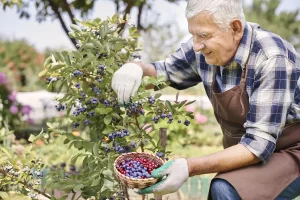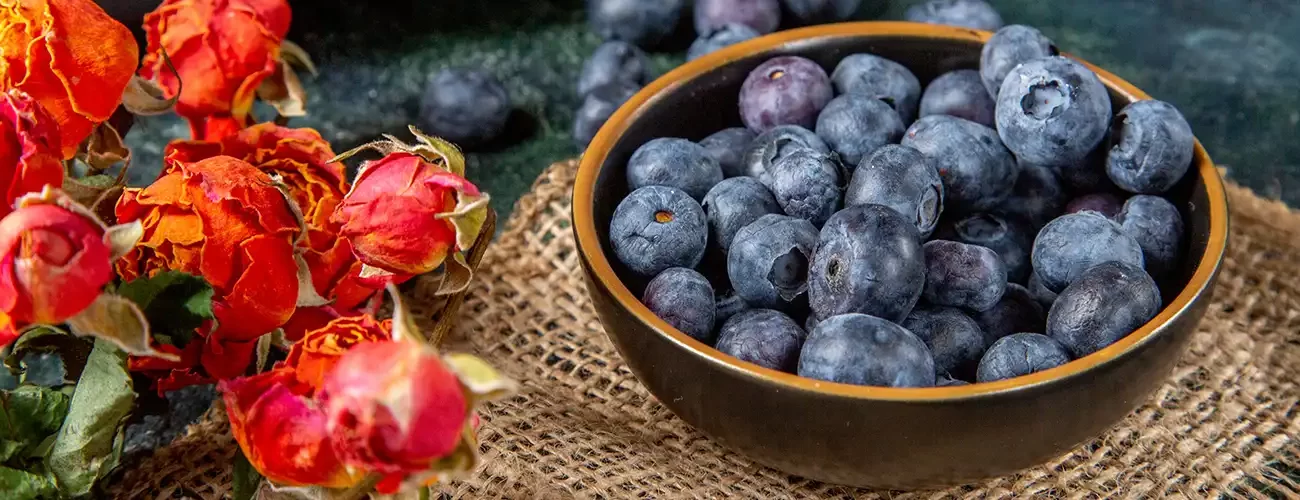No products in the cart.
How are blueberries grown? blueberry plantations from A to Z. Blueberries are without a doubt among the most well-known fruits in the world. The Ericaceae family’s and the Vaccinium genus’ blueberry is a shrub with purple fruits that can be grown, cultivated, and harvested in temperate and cold climates.
The most significant cultivars of blueberries are the wild blueberry, also known as the short bush (Lowbush) also known as Vaccinium corymbosum, the highbush blueberry, also known as Vaccinium angustifolium, and the rabbiteye blueberry, also known as Vaccinium ashei, which is a native species of the southeastern United States. Each of these cultivars has specific requirements for growth and conditions.
How are blueberries grown? Blueberry plantings from A to Z
There are certain tips for planting blueberries that we mention in this article:
- Species selection
Highbush blueberries, lowbush blueberries, and shortbush blueberries that grow wild are the three main types of blueberries. Southern blueberries perform better in more temperate and warmer areas and have high resistance to heat and drought conditions, but they do not grow in the north, unlike northern high stem blueberries, which can be grown in colder areas and has a high resistance to cold weather conditions. So, based on your location, pick the appropriate variety.
- The best time to plant blueberries
The blueberry plant can be grown primarily in cold and temperate climates. Blueberry planting is best done during a season with enough light. Blueberry planting is best done in the spring or fall in temperate climates. You can plant the seeds in the fall to germinate in the spring if you live in a cooler climate. Therefore, the most crucial step is to assess the regional conditions and choose the best time to plant blueberries based on them.
- Soil preparation
Make the soil ready before you plant the blueberries. Remove the weeds and stones first. Then add nutrients to the soil, such as compost or animal manure. The soil should have a suitable acidity, or a pH between 4.5 and 5.5, and should be well-drained. The soil should also have organic matter and be well drained. Blueberry growth is made possible by the use of natural peat moss with an acidic pH.
The soil shouldn’t be clay-based when planting blueberry seedlings because doing so will prevent the blueberry bush from growing and producing fruit. Making a hole that is 1 meter by 1 meter in size is the first step. The soil should then be removed, and the acidic peat moss, pine tree leaves (suitable for indoor plants), or old and rotten forest leaves should be mixed in at a ratio of 1 to 1. Alternately, coniferous trees with the right pH balance should have their leaves filled.
- Planting blueberry seeds
For better germination when planting blueberries, use chilled seeds. Wide pots are preferable when planting blueberry seeds because they make it easier to move the seedlings to larger pots or the farm and because the holes in the bottom of the pot are better suited for drainage and ventilation. Peat moss soil should first be mixed with water to improve moisture absorption. After adding the soil to the pot, smooth it out without pressing on the soil’s surface.
For blueberry bushes to have enough room to grow, the spacing between the seeds should be between 30 and 60 cm if they are planted outdoors.
- Providing light, humidity and suitable temperature for blueberry planting
In order to avoid disturbing the soil layers, it is preferable to use water spray to provide moisture. The surface of the pot should therefore be covered with transparent plastic to maintain moisture after the seeds have been planted. Note that the plastic cover is still on the pot even after the seeds have germinated.
The need for sufficient light for blueberry seeds is a crucial consideration when planting blueberry seeds. They should therefore be spread on the soil’s surface rather than being buried. Consider planting blueberries in an area that receives daytime sunlight as well. It is preferable to place the pot under LED or fluorescent light for 8 to 10 hours in order to get the light that the plant needs to grow.
The right temperature, which should be between 15 and 20 degrees Celsius in this case, is another essential requirement for the germination of blueberry seeds. Many regions allow for planting this plant in the fall and winter.
How to irrigate blueberries in field conditions
For blueberries to grow properly and yield fruit of high quality, proper watering is crucial. Below are some details on irrigation for blueberries:
- Blueberries require regular watering throughout the growing season after the seeds are planted. However, keep in mind that the soil is always wet and that too much watering can harm the roots.
- While the soil shouldn’t be constantly wet, blueberries need the right amount of moisture. Blueberries typically require 2 to 3 centimeters of water per week. However, this sum may vary based on the local climate and soil characteristics.
- Deep and consistent irrigation, which means watering the soil to the depth of the blueberry roots on a regular basis, is preferable to abundant and scattered irrigation because it prevents superficial rooting and sunburn.
- The morning or evening are the ideal times to water blueberries. Evaporation is lower and plant water uptake is better during these times. Additionally, to prevent illnesses and sunburn, avoid watering during hot and sunny periods.
- A reel irrigation machine is a system that irrigates a field in a strip and is used to water short and tall plants in clay and sandy lands, smooth and unevenly. Other irrigation methods include drip irrigation, direct irrigation on the soil, and reel irrigation systems. Getting water close to the blueberry roots is the main objective of effective blueberry irrigation.
- The most crucial aspect of the frequency of watering is to always check the soil’s moisture level before watering. You can use a soil moisture sensor or your fingers to gauge the moisture content. Only water the soil when it is deficient in moisture.

How to prune blueberries?
To prune blueberries, you can follow these steps:
- End of winter or early spring, that is, before the start of the plant’s active growth season, is the best time for blueberry pruning.
- In order to prune blueberries, cut off weak and aging branches. Blueberries will produce fruit on new branches the following year, so prune the branches that bore fruit the previous year as well.
- Cut and remove any branches that have disease, blight, or weakness. This aids in limiting the spread of pathogens and pests.
- Blueberry side branches should also be pruned. The blueberry tree can be balanced and shaped by pruning the branches that have grown more than 30 cm above the ground.
- After pruning, gather and remove the branches and leaves that were cut. By doing this, you can stop diseases and pests from spreading to healthy blueberry plants.
Blueberry cultivation problems and their solutions
In general, there are few diseases and pests that affect blueberries. Aphids on young blueberry shoots, powdery mildew, and vine aphids are a few common issues to be aware of. In order to properly care for blueberry bushes, weeding, managing pests and diseases, and controlling plant growth are all necessary.
Additionally, keep an eye out for yellowing leaves, which may indicate chlorosis. This is because the pH of the soil has changed, and if it is not corrected, the blueberries will perish. When growing blueberries in containers or in soil that isn’t naturally acidic, you should fertilize with fresh compost and water the plants to balance the pH and strengthen the soil’s structure.
In order to properly care for blueberry bushes, weeding, managing pests and diseases, and controlling plant growth are all necessary. To get the necessary advice on planting and caring for blueberries in your area, it is best to speak with a local farmer or an expert in this field before planting blueberries. The Tamin Tejarat Tavana Company provides training in healthy crop production, new and effective irrigation techniques, fertilization programs, farm planning, and garden management to farmers, ranchers, gardeners, greenhouse owners, and everyone else who needs it.
